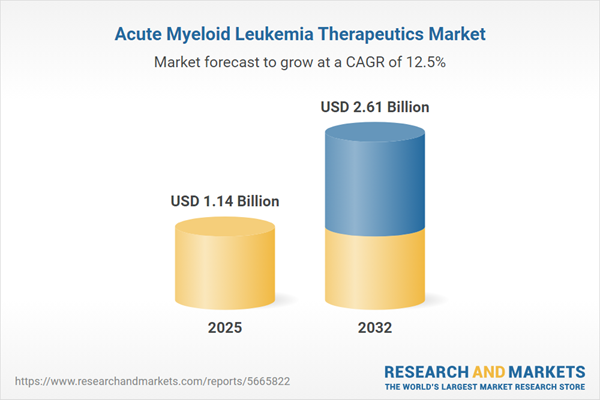Speak directly to the analyst to clarify any post sales queries you may have.
The acute myeloid leukemia (AML) therapeutics market is evolving rapidly as new targeted treatments, innovative clinical workflows, and shifting regulatory frameworks redefine development and commercialization strategies for senior stakeholders.
Market Snapshot: Acute Myeloid Leukemia Therapeutics Market
The Acute Myeloid Leukemia Therapeutics Market grew from USD 1.02 billion in 2024 to USD 1.14 billion in 2025. It is expected to continue growing at a CAGR of 12.46%, reaching USD 2.61 billion by 2032.
Scope & Segmentation
This comprehensive research report offers stakeholders a detailed breakdown of core segments, technology applications, and regional perspectives across the AML therapeutics space.
- Therapy Type: Biologics (antibody drug conjugates, fusion proteins, monoclonal antibodies), cell therapy (CAR T cell therapy, stem cell transplantation), gene therapy, small molecule agents (BCL-2 inhibitors, DNA methyltransferase inhibitors, tyrosine kinase inhibitors including FLT3 and KIT inhibitors).
- Mechanism of Action: BCL-2 inhibitors, DNA methyltransferase inhibitors, HDAC inhibitors, immunomodulatory agents, tyrosine kinase inhibitors targeting specific oncogenic pathways.
- Line of Therapy: First line, second line, third line and beyond treatment regimens, addressing evolving clinical demands.
- End User: Hospital pharmacies, retail pharmacies, specialty clinics managing inpatient, outpatient, and complex therapeutic administration.
- Route of Administration: Intravenous, oral, and subcutaneous therapies supporting diverse treatment protocols and improved patient adherence.
- Patient Age: Adult, geriatric, and pediatric populations with tailored safety and efficacy requirements.
- Regional Coverage: Americas (North America, Latin America), Europe, Middle East & Africa, and Asia-Pacific, with detailed analysis of key countries within these territories.
- Company Coverage: Reviews significant developments and strategies across leading firms such as AbbVie, F. Hoffmann-La Roche, Pfizer, Jazz Pharmaceuticals, Novartis, Bristol Myers Squibb, Astellas Pharma, Agios Pharmaceuticals, Otsuka Pharmaceutical, and Daiichi Sankyo Company.
Key Takeaways
- Advancements in molecular diagnostics and clinical research are reshaping AML therapy pathways, enabling a shift toward precision medicine models that integrate disease-specific biomarkers for patient selection.
- Technological integration is accelerating drug discovery and development efficiency, with AI-driven analytics optimizing target validation and candidate screening processes.
- Collaborative frameworks, including partnerships among academia, biotechnology startups, and multinational pharmaceutical firms, are speeding the translation of research breakthroughs into clinical application.
- Adaptive regulatory pathways and evolving approval mechanisms are reducing time to market for innovative AML therapies, balancing rapid patient access with rigorous safety standards.
- Real-world evidence initiatives and digital health solutions are strengthening outcome tracking, supporting regulatory submissions, and informing reimbursement discussions by capturing longitudinal patient data.
- The competitive landscape is being shaped by a convergence of outcomes-based contracting, integration of advanced clinical trial designs, and expanded patient engagement efforts across regions.
Tariff Impact on AML Therapeutic Supply Chains
Recent tariff measures affecting pharmaceutical imports and raw materials have driven companies to reconsider supply chain strategies, leading to increased localization of manufacturing and strategic partnerships with domestic contract development organizations. Enhanced focus on diversifying supplier networks and optimizing logistics is essential for maintaining cost control, minimizing production delays, and ensuring reliable market access for critical hematology products. Regulatory cooperation and preferential trade agreements have become instrumental in facilitating smoother distribution of life-saving therapies, supporting patient accessibility amid shifting trade policies.
Methodology & Data Sources
This report integrates qualitative interviews with key stakeholders—including clinicians and industry executives—and secondary research from peer-reviewed journals, regulatory filings, and corporate disclosures. Triangulation techniques validate all findings to ensure accuracy and minimize bias, while analytic frameworks such as scenario planning and SWOT assessments structure actionable insights for decision-makers.
Why This Report Matters
- Provides a strategic foundation for aligning R&D priorities, operational resources, and commercial strategies in a rapidly changing AML treatment landscape.
- Supports proactive risk mitigation and opportunity identification by mapping evolving regulations, reimbursement models, and regional therapy adoption trends.
- Enables industry leaders to anticipate inflection points and optimize patient engagement programs by leveraging real-time and real-world data.
Conclusion
The AML therapeutics market is advancing through innovation, collaboration, and operational agility. Executives can leverage this research to shape robust strategies, strengthen market presence, and drive better patient outcomes in an evolving global environment.
Additional Product Information:
- Purchase of this report includes 1 year online access with quarterly updates.
- This report can be updated on request. Please contact our Customer Experience team using the Ask a Question widget on our website.
Table of Contents
3. Executive Summary
4. Market Overview
7. Cumulative Impact of Artificial Intelligence 2025
Companies Mentioned
The companies profiled in this Acute Myeloid Leukemia Therapeutics market report include:- AbbVie Inc.
- F. Hoffmann-La Roche Ltd
- Pfizer Inc.
- Jazz Pharmaceuticals plc
- Novartis AG
- Bristol Myers Squibb Company
- Astellas Pharma Inc.
- Agios Pharmaceuticals, Inc.
- Otsuka Pharmaceutical Co., Ltd.
- Daiichi Sankyo Company, Limited
Table Information
| Report Attribute | Details |
|---|---|
| No. of Pages | 180 |
| Published | November 2025 |
| Forecast Period | 2025 - 2032 |
| Estimated Market Value ( USD | $ 1.14 Billion |
| Forecasted Market Value ( USD | $ 2.61 Billion |
| Compound Annual Growth Rate | 12.4% |
| Regions Covered | Global |
| No. of Companies Mentioned | 11 |









